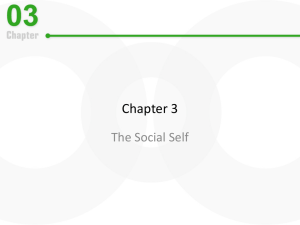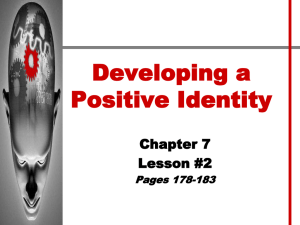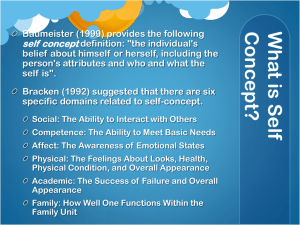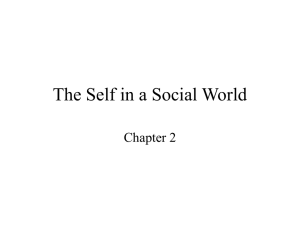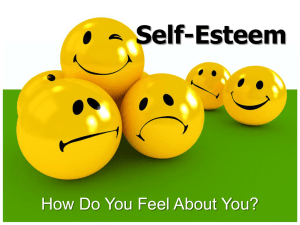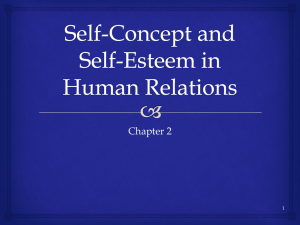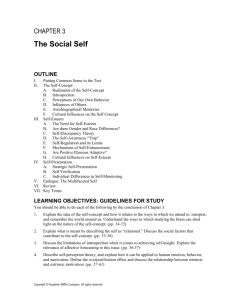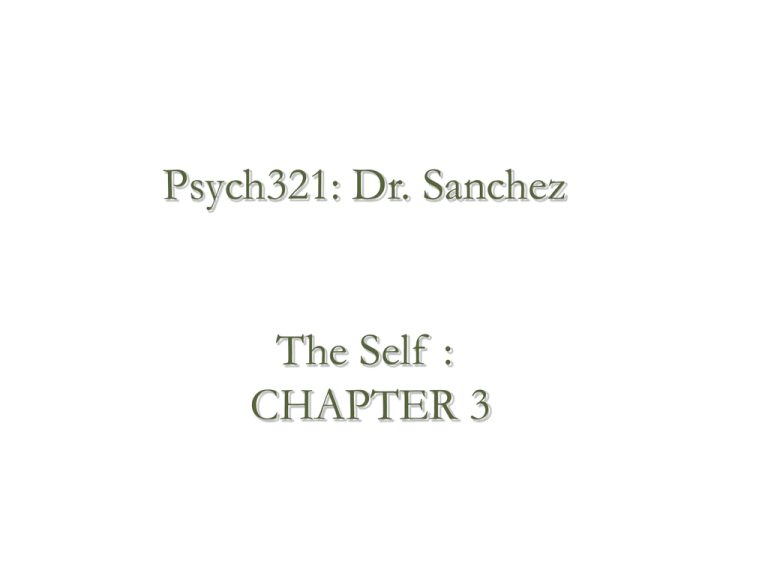
Psych321: Dr. Sanchez
The Self :
CHAPTER 3
1
The Role of the “Self”
• The self concept is at the center of our
understanding of the social world.
• Private, inner self – how we truly see
ourselves
• Public, “outer” self – how we want others to
see us
2
The ABCs of the Self
• Affect: How do we evaluate ourselves,
enhance our self-images, and defend against
threats to our self-esteem?
• Behavior: How do we regulate our actions and
present ourselves according to interpersonal
demands?
• Cognition: How do we come to know
ourselves, develop a self-concept, and
maintain a stable sense of identity?
3
COGNITIVE:
The Self-Concept
• Self is an important object of our attention.
– Cocktail party effect.
• Self-Concept: The sum total of beliefs that
people have about themselves.
• Self-concept is made up of self-schemas.
– Self-Schema: Beliefs about oneself that guide
processing of self-relevant information.
4
Beginnings of the Self-Concept
• Social neuroscience explores the brain in relation
to the self
• Do non-humans show self-recognition.
– The great apes! Maybe elephants & dolphins
– 18-24 months babies
5
Where Does Our Self
Concept Come From?
6
Who Am I?
• Who am I?
• I am________
• 20 statements
7
Source #1: Introspection
• Self knowledge through looking inward at
one’s own thoughts, feelings, and behavior.
• Does introspection lead to accurate selfknowledge?
– Wilson (2002): Introspection can sometimes
impair self-knowledge!
8
Other Problems With Introspection
• We have difficulty in predicting responses to
future emotional events.
• We tend to overestimate the strength and
duration of our emotional reactions.
9
Why a Durability Bias?
• For negative events, we do not fully
appreciate our…..
• We focus only on the emotional impact of a
single event, …..
10
Source #2: Perceptions ofOur
Own Behavior
• Daryl Bem (1972): People can learn about
themselves simply by watching their own
behavior.
• Self-Perception Theory: When internal
cues are difficult to interpret, people gain
insight by observing their own behavior.
11
Perceptions of Our Own Behavior
• Self–Other Knowledge Asymmetry (SOKA)
suggests:
– we know ourselves better than others for
traits that are “internal” and hard to observe
(such as how optimistic, anxious, or easily
upset a person is)
– there is no self-other difference when it comes
to traits that are “external” and easy to
observe (such as how quiet, sociable, or messy
a person is).
The Self-Other Knowledge Asymmetry
(SOKA) Model
Self-Perceptions of Emotion
• Facial Feedback Hypothesis: Changes in facial
expression can lead to changes in the
subjective experience of emotions.
• Laird (1974): Facial expressions affect emotion
through process of self-perception.
– Alternative explanation: Facial movements evoke
physiological changes that produce an emotional
experience.
14
Self-Perceptions of Motivation
• Intrinsic versus Extrinsic Motivation.
– Intrinsic Motivation: Originates in factors
within a person.
– Extrinsic Motivation: Originates in factors
outside the person.
• What happens to intrinsic motivation when
associated with rewards?
– Overjustification effect
15
Paradoxical Effects of Reward on Intrinsic
Motivation
16
Source #3:
Influences of Other People
• People tend to describe themselves in ways
that set them apart from others in their
immediate vicinity.
• The self is “relative.”
– We define ourselves in part by using others as a
benchmark.
17
Social Comparison Theory
• Festinger (1954): When uncertain about our abilities
or opinions, we evaluate self through comparisons
with similar others.
• Key Questions:
– When do we turn to others for comparative
information?
• Sometimes when objective standards are available
• Uncertainty
18
Source #4: Autobiographical Memories
• Essential for a coherent self-concept.
• Typically report more events from the recent
than the distant past.
19
Source #4: Autobiographical Memories
(cont.)
• Flashbulb memories serve as prominent
landmarks in our autobiographies.
– Not necessarily accurate, but they “feel” special
• Autobiographical memory is a vital part of,
and can be shaped by, our identity.
– Often motivated to distort the past in ways that
are self-inflated.
20
Distortions in Memory of High School
Grades
From Bahrick et al., Psychological Science, 1996, Vol. 7, pp. 266-271. Copyright (c)
1996 Blackwell Publishing. Reprinted with permission.
21
WHICH DO YOU CHOOSE?
22
Which Colored Pen Would You
Like?
80
70
60
Percentage
50
Choosing
40
Unique Colored
30
Pen
20
10
0
American
East Asian Heritage
23
Which Subfigures Do Your Prefer?
Figure 3.4: Which Subfigures Do
You Prefer?
H. Kim and H.R. Marcus "Deviance or Uniqueness, Harmony or Conformity? A Cultural Analysis" (1999) from JOURNAL OF PERSONALITY AND
SOCIAL PSYCHOLOGY, 77, 785-800. Copyright (c) 1999 by the American Psychological Association. Reprinted with permission.
Copyright © Houghton Mifflin Company. All rights reserved.
27
24
Source #5: Cultural Perspectives
• Self-concept is also influenced by cultural
factors.
• Contrasting cultural orientations:
– Individualism/Independence: One’s culture values
independence, autonomy, and self-reliance.
25
Cultural Conceptions of Self
26
Influence of Cultural Orientation
on Self
• Individualistic cultures: Giving priority to one’s
own goals over group goals; emphasizes
uniqueness
• Collectivistic cultures: Giving priority to goals
of one’s groups (e.g., family); emphasizes
identity in relation to others
27
Self Esteem
The affective component
of the self
28
Why Do We Have a Need for
Self-Esteem?
• Leary & Baumeister (2000): People are
inherently social animals.
29
Terror Management Theory
Greenberg, Solomon, & Pyszczynksi, 1997
• People are biologically programmed for selfpreservation
• People are terrified by their own mortality
30
The Need for Self-Esteem
• Those with a positive self-image tend to be
happy, healthy, productive, and successful.
• Those with a negative self-image tend to be
more depressed, pessimistic about the future,
and prone to failure.
31
Contingencies of Self-Worth
• People’s beliefs about what they must be or
do to have worth—sources of SE.
• People differ in the domains in which they
base self-esteem
• Self-esteem depends on success and failure in
these domains
• Fall on a continuum from internal to external
32
Influences of Gender,
Race, and Culture
• Like individuals, social and cultural groups
differ in their self-esteem.
• Gender differences?
– Among adolescents and young adults, males
outscore females on various general measures
of self-esteem.
– But this difference is very small, particularly
among older adults.
33
Self-Esteem in
U.S. Minority Groups
From J. M. Twenge and J. Crocker, “Race and Self-Esteem: Meta-Analysis Comparing Whites, Blacks, Hispanics,
Asians, and American Indians,” Psychological Bulletin, Vol. 128, 2002, pp. 371-408.
34
Exceptions to Benefits of High SE
• High SE can be related to lower social
sensitivity
• High SE may be fragile
• High SE might not reflect the cultural goal,
so it might not correlate with happiness
35
Self-Discrepancy Theory
• Self-esteem reflects the match — or mismatch —
between how we see ourselves and how we want to
see ourselves.
– Actual self
• One’s self-esteem and emotional well-being can be
predicted by examining the discrepancy between
one’s “actual self” and one’s “self-guides.”
36
Self-Discrepancy Theory
• Discrepancy between actual self and ought
self – leads to
• Discrepancy between actual self and ideal self
– leads to
37
Self-Discrepancy Theory (cont.)
• Self-esteem depends on a number of factors:
– Amount of discrepancy between actual self and
self-guide.
– The importance of the discrepancy to the self.
– The extent to which one focuses on one’s selfdiscrepancies.
• What makes us more or less focused on our
personal shortcomings?
38
Self-Awareness Theory
• We are not usually self-focused; however,
certain situations may cause us to become
objects of our own attention.
• When we become more self-aware, we
naturally begin to compare behavior with
some standard. This comparison often results
in a negative discrepancy and a temporary
reduction in self-esteem.
39
The Causes and Effects
of Self-Awareness
(Carver & Scheier, 1981)
40
Beaman et al.’s Halloween Study (self-focusing
situation)
40
35
Percentage
who violated
30
25
20
one piece of
candy request 15
10
5
0
No Mirror
Mirror Present
41
God: Like a Camera in the Sky?
• For people of faith, thinking about God
should trigger a state of self-focus in the
way that cameras and microphones do.
How Self-Conscious are You?
Self-Focusing Persons
• Certain individuals are characteristically
more self-focused than others.
• Private vs. public self-consciousness.
– Private self-consciousness: Tendency to
introspect about inner thoughts and
feelings.
– Public self-consciousness: Tendency to
focus on outer public image.
44
Draw A Capital E on Your
Forehead
Percentage
Oriented "E"
for Outside
Observer
45
40
35
30
25
20
15
10
5
0
High
Low
Level of Public Self-Consciousness
45
Self-Regulation
• Self-regulation is the process by which we
seek to control or alter our thoughts, feelings,
behaviors, and urges.
• Self-regulation may be a better predictor of
life success than self-esteem
46
Limits of Self-Regulation
• Self-control is a limited resource that can
temporarily be depleted by usage
• Example: Ps watching upsetting film about
injured animals; IV=self-regulation
– 1/3 told to stifle emotional responses
– 1/3 told to amplify responses
– 1/3 given no instructions
– DV: physical strength before and after
47
Self-Control as a
Limited Inner Resource
Muraven & Baumeister, 1998..
48
Ironic Processes
• Wegner (1994): Sometimes the harder we try
to inhibit a thought, feeling, or behavior, the
less likely we are to succeed.
• “Ironic operating process”
49
Mechanisms of Self-Enhancement
• How does the average person cope with
his or her faults, inadequacies, and
uncertain future?
• We often exhibit implicit egotism, a
tendency to hold ourselves in high regard.
50
The Better-Than-Average Effect
Method #1: Self-Serving Cognitions
• People tend to take credit for success and
distance themselves from failure.
• Most people are unrealistically optimistic.
52
Method #2: Self-Handicapping
• Why do we make excuses?
– Way of protecting self from seeing failure as
due to a lack of ability.
• Self-Handicapping:
53
Self Handicapping Scale
•
•
•
•
•
•
•
•
•
•
1.I tend to make excuses when I do something
wrong.
2.I tend to put things off to the last minute.
3.I suppose I feel “under the weather” more
often than most people.
4.I always try to do my best no matter what.
5.I am easily distracted by noises or my own
daydreaming when I try to read.
6.I try not to get too intensely involved in
competitive activities so it won’t hurt too much
if I lose or do poorly.
7.I would do a lot better if I tried harder.
8.I sometimes enjoy being mildly ill for a day or
two.
9.I tend to rationalize when I don’t live up to
others’ expectations.
10.I overindulge in food and drink more often
than I should.
54
Individual Differences
in Self-Handicapping
• Gender differences exist in how we selfhandicap
• Some set their goals too high, which sets
up failure — but not due to a lack of ability.
• Some engage in “sandbagging.”
Why Self-Handicap?
• An ingenious strategy.
– Insulates the self from failure and enhances the
self by success.
• Self-handicapping does have its costs.
56
Method #3: Basking in the Glory of Others
• To raise our self-esteem we often bask in reflected
glory (“BIRG”) by associating with others who are
successful.
• To protect our self-esteem, we will “cut off
reflected failure” (“CORF”) by distancing ourselves
from others who fail or are of low status.
57
Would You Like a Team Badge?
70
60
50
Percentage 40
Taking Badge
30
Home
20
10
0
Success
None
Failure
Type of Feedback
58
Method #4: Downward Social
Comparison
• When self-esteem is at stake, tend to make
comparisons with others who are worse off.
• Will make temporal comparisons between past and
present selves.
• If experiencing a tragic life event, tend to:
– Affiliate with others in same predicament who are
adjusting well (possible role models).
– Compare ourselves with others who are worse off.
59
Are Positive Illusions Adaptive?
• Those with the most realistic view of
themselves are those who are depressed
or low in self-esteem.
• Positive illusions are “health-protective”
psychological resources that help people
cope with adversity.
• But, positive illusions can lead to chronic
patterns of self-defeating behaviors, if
they’re unrealistic.
60
The Dark Side of High Self-Esteem
Heatherton & Vohs, 2000.
61
Culture and Self-esteem
• Differences between individualistic and
collectivist cultures?
• Individualistic Societies report higher SE than
collectivistic but
Self-Presentation
The behavioral component
of the self
63
Self-Presentation
• The process by which we try to shape what
others think of us and what we think of
ourselves.
• Two types of self-presentation, each serving a
different motive:
– Strategic self-presentation.
– Self-verification.
64
Strategic Self-Presentation
• Our efforts to shape others’ impressions in
specific ways to gain influence, power,
sympathy, or approval.
• Common strategic self-presentation goals:
– Ingratiation:
– Self-Promotion:
65
Strategic Self-Presentation
Self-Verification
• Desire to have others perceive us as we truly
perceive ourselves.
• Do we self-verify negative self-concepts?
67
Self-Monitoring
• Tendency to regulate one’s own behavior to
meet the demands of the situation.
• High Self-Monitors: Sensitive to strategic selfpresentation concerns.
• Low Self-Monitors: More concerned with selfverification.
• Is it better to be a high or low self-monitor?
68
Epilogue: The Multifaceted Self
• Historically, the self has been viewed as an
enduring aspect of personality
– Stable over time and slow to change.
• But at least part of the self is malleable.
– Molded by life experiences.
– Biased in our own memories
– Varies from one situation to the next.
• Self is complex and multifaceted,
not simple.
69

